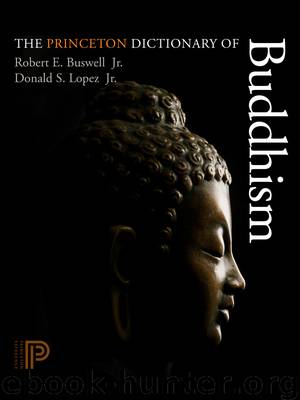The Princeton Dictionary of Buddhism by Robert E. Buswell Jr. & Donald S. Lopez Jr

Author:Robert E. Buswell Jr. & Donald S. Lopez Jr. [Buswell, Robert E. Jr. & Lopez, Donald S. Jr.]
Language: eng
Format: epub
Tags: Religion, Buddhism, General, Reference, Encyclopedias, Dictionaries, History, Asia, Social Science, Black Studies (Global)
ISBN: 9781400848058
Google: DXN2AAAAQBAJ
Amazon: 0691157863
Publisher: Princeton University Press
Published: 2013-11-23T23:00:00+00:00
nirmāṇarati. (P. nimmānarati; T. ’phrul dga’; C. huale tian; J. kerakuten; K. hwarak ch’ŏn 化樂天). In Sanskrit, “enjoying creations” or “enjoying emanations,” the fifth (in ascending order) of the six heavens (SVARGA) of the sensuous realm (S. KĀMADHĀTU), located above Mount SUMERU and thirty-two thousand leagues (YOJANA) above the immediately preceding heaven, TUṢITA. The heaven receives its name because the divinities reborn there create their own magical emanations that they control. In this heaven, males and females experience sexual pleasure without engaging in physical contact but merely by smiling at each other. The children produced from their union have the appearance of nine-year-old children at birth. The life span in this heaven is said to be eight thousand years, in which each day is as long as eight hundred human years.
nirmita. (P. nimmita; T. sprul pa; C. hua; J. ke; K. hwa 化). In Sanskrit, “conjured,” referring to something perceived by the sensory organs to be real but that is in fact illusory, like the moon on the surface of a lake or the water in a mirage. The term is often associated in Buddhist literature with the various doubles the Buddha conjures of himself in order to bring varying types of sentient beings to liberation (see NIRMĀṆAKĀYA).
nirodha. (T. ’gog pa; C. mie; J. metsu; K. myŏl 滅). In Sanskrit and Pāli, “cessation,” “extinction,” or “suppression,” referring especially to the extinction of a specific affliction (KLEŚA) or group of afflictions. Because NIRVĀṆA is the cessation of all action (KARMAN) and affliction, it is thus a form of nirodha. The “truth of cessation,” or NIRODHASATYA, is the third of the FOUR NOBLE TRUTHS articulated by the Buddha in his first sermon, “Setting in Motion the Wheel of Dharma” (P. DHAMMACAKKAPPAVATTANASUTTA; S. DHARMACAKRAPRAVARTANASŪTRA). Because nirodha is an absence and hence does not change from moment to moment, it is sometimes classified as a permanent factor (NITYADHARMA). Two types of nirodha are described in ABHIDHARMA literature. PRATISAṂKHYĀNIRODHA, or “analytical cessation,” refers to a cessation that occurs as a result of meditative analysis of the real nature of phenomena; it is one of the uncompounded factors (ASAṂSKṚTADHARMA) recognized in both the SARVĀSTIVĀDA-VAIBHĀṢIKA and YOGĀCĀRA schools. APRATISAṂKHYĀNIRODHA, or “nonanalytical cessation,” refers to a mere absence, such as the temporary absence of hunger after a meal, or to an uncompounded factor (asaṃskṛtadharma) that suppresses the production of all other dharmas, ensuring that they are restrained from ever again arising in the present. See also NIRODHASAMĀPATTI.
nirodhasamāpatti. (T. ’gog pa’i snyoms ’jug; C. miejin ding; J. metsujinjō; K. myŏlchin chŏng 滅盡定). In Sanskrit and Pāli, “equipoise of cessation,” also known as “the cessation of perception and sensation” (SAṂJÑĀVEDAYITANIRODHA). Nirodhasamāpatti constitutes the ninth and highest level of meditative attainment in the mainstream Buddhist schools, achieved after the fourth meditative absorption of the immaterial realm (ĀRŪPYADHĀTU) and thus transcending the four subtle-materiality absorptions (RŪPĀVACARADHYĀNA) and four immaterial absorptions (ĀRŪPYĀVACARADHYĀNA). Nirodhasamāpatti engenders a state of suspended animation: the meditator remains alive, but all physical and mental activities cease for a fixed, but temporary, period of time.
Download
This site does not store any files on its server. We only index and link to content provided by other sites. Please contact the content providers to delete copyright contents if any and email us, we'll remove relevant links or contents immediately.
| Dictionaries | English |
| Foreign Language Dictionaries & Thesauruses | Lexicography |
| Slang & Idioms | Synonyms & Antonyms |
| Thesauruses |
A Dictionary of Sociology by Unknown(3016)
The Art of Dramatic Writing: Its Basis in the Creative Interpretation of Human Motives by Egri Lajos(3014)
The Dictionary of Body Language by Joe Navarro(2946)
0041152001443424520 .pdf by Unknown(2783)
How The Mind Works by Steven Pinker(2729)
Day by Elie Wiesel(2717)
Merriam-Webster's Collegiate Thesaurus, Second Edition by Merriam-Webster Inc(2710)
The Meaning of the Library by unknow(2503)
The Official Guide to the TOEFL Test by ETS(2285)
A History of Warfare by John Keegan(2183)
The Emotion Thesaurus: A Writer's Guide to Character Expression by Puglisi Becca & Ackerman Angela(2121)
Emotion Amplifiers by Angela Ackerman & Becca Puglisi(2006)
MASTER LISTS FOR WRITERS: Thesauruses, Plots, Character Traits, Names, and More by Bryn Donovan(1906)
The Cambridge Guide to English Usage by PAM PETERS(1880)
Merriam-Webster's Pocket Dictionary by Merriam-Webster(1880)
Star Wars The Rise of Skywalker The Visual Dictionary by Pablo Hidalgo(1840)
Lucky Jim by Kingsley Amis(1697)
American Accent Training by Ann Cook(1635)
Word by Word by Kory Stamper(1613)
